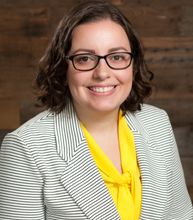
While growing up in Brooklyn, CSN’s Maria Katradis often served as an interpreter when her Greek-speaking grandparents needed medical care, translating provider letters and accompanying them on hospital visits. The experience helped her see the systemic inequities present in the health care system, as well as the intersectional impact that culture, language, and other diversity dimensions could have on a person’s access to health care.
“I realized that there are gatekeepers to information, and that different levels of health literacy can affect a person’s health outcomes,” says Katradis.
Katradis’ work has been informed by these experiences. At CSN, she is helping states push towards health equity—the ability of every parent, child, and family to achieve their full health potential without discrimination or barrier. At EDC, Katradis collaborates with states and communities to implement the First 10 model to establish high-quality, cohesive educational, parenting, and community supports. Katradis also co-chairs EDC’s Equity, Diversity, & Inclusion (EDI) Committee, which supports organizational efforts to implement EDI initiatives.
As a technical assistance provider for CSN, Katradis helps state health department practitioners center health equity in their planning. She has also co-developed a planning tool that helps state teams turn their health equity goals into concrete actions that benefit populations disproportionately impacted by inequities.
“We know that a lot of states have health equity vision statements, but they just don’t know how to implement practices that produce health equity,” she says. “This planning tool helps them think about who is at table, who is and is not being heard, and whether there is sufficient representation from different communities whose needs should be centered.”
Katradis also brings a health equity lens to her work on youth suicide prevention. While a lot of attention has been paid to the rise in suicide rates among middle-aged white men, she notes that peak suicidality occurs in the early-20s for Black men and the late-20s for Black women. Likewise, rates of child and adolescent deaths by suicide have been increasing across all races and ethnicities. “So if you are waiting until middle age to do suicide prevention, then that’s too late for many populations,” she says. She urges this work to start a lot earlier so that children can grow up to be resilient, healthy adults.
Whether she is providing TA, delivering a webinar, or working with school health staff, Katradis always keeps health equity at the center of her work.
“Creating a system where people can advocate for themselves and their families without going through hoops and ladders is important,” she says.